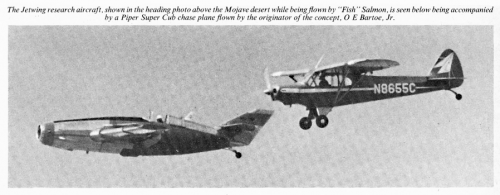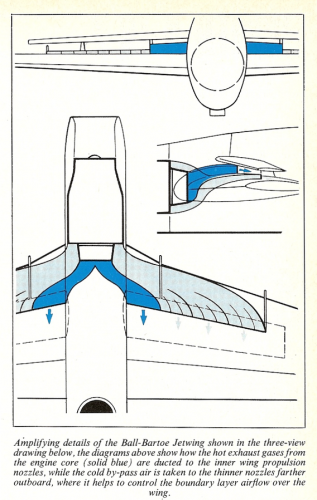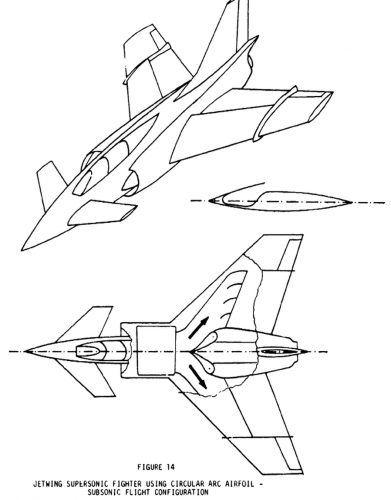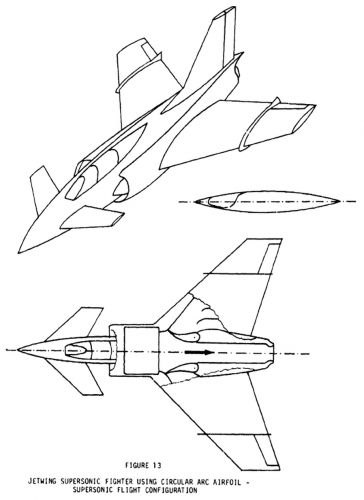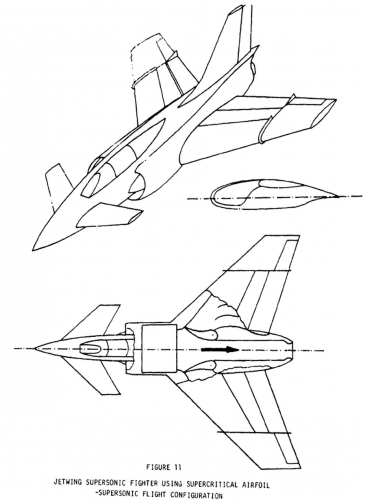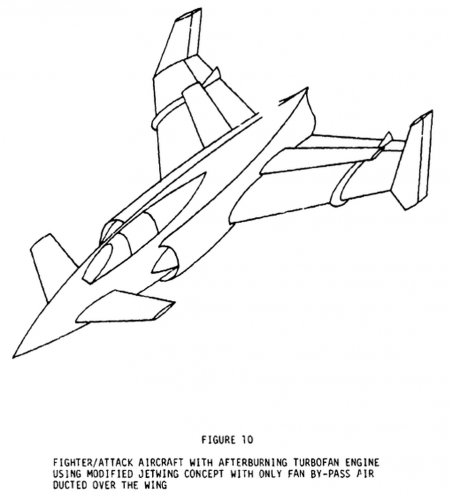- Joined
- 1 May 2007
- Messages
- 2,458
- Reaction score
- 1,450
The "Jetwing" concept was conceived by Mr. 0. E. Bartoe
while he was Vice President and General Manager of Ball Brothers
Research, a division of the Ball Corporation. Mr. Bartoe felt so
strongly about his ideas that he was able to convince the management
of Ball Corporation that they were worth spending corporate
funds to develop. This led to the formation of a separate company,
called Ball-Bartoe Aircraft Company (with Mr. Bartoe as its
President), to develop the "Jetwing" idea into a proof of concept
research aircraft.
Development started on the Jetwing research airplane in
1973. The airplane was completed and ready for testing by
December of 1976.
Full scale testing started in December of 1976 in the NASA
Ames Research Center 40' x 80' wind tunnel. A large matrix of
aircraft configurations were tested in the full scale wind tunnel.
Other data from these tests are also available for comparison with
flight test data and with data from other USB concepts.
The first flight was conducted at Mojave, California on July
11, 1977, by Mr. H. R. Salmon.
Forty seven flights were flown at Mojave for a total of 34 hours.
Upon completion of testing at Mojave, the aircraft was
ferried to the Ball-Bartoe Aircraft Company facility at Boulder,
Colorado, where some testing and demonstration flying continued.
An additional 44 flights and 32 flight hours were accumulated upon
the aircraft during the ferry trip and test flying at Boulder.
In December of 1978, the Jetwing research aircraft and its
conceptual patents were donated to the University of Tennessee
Space Institute.
On February 19, 1980, the University of Tennessee received
Contract N00019-80-C-0126 for the flight and ground testing which
is described in the report entitled :-
"A FLIGHT TEST EVALUATION OF THE BALL-BARTOE JETWING
PROPULSIVE LIFT CONCEPT"
http://handle.dtic.mil/100.2/ADA103579
This report contains the following conclusion :-
"That strong consideration be given to continued development
of such technology for application to future military aircraft."
In 2007, the Jetwing was donated by UTSI to the
Wings Over the Rockies Air and Space Museum in Denver, Colorado.
Sources :-
"Jetwing from Colorado", Air International, February 1978, pp.69-71
"Whispering Jetwing", Aeroplane Monthly, July 1978, pp. 367-369
http://www.airspacemag.com/history-of-flight/Oldies-and-Oddities-Blown-Away.html
http://www.flickr.com/photos/landoni/sets/72157605295788377/
http://handle.dtic.mil/100.2/ADA103579
cheers,
Robin.
while he was Vice President and General Manager of Ball Brothers
Research, a division of the Ball Corporation. Mr. Bartoe felt so
strongly about his ideas that he was able to convince the management
of Ball Corporation that they were worth spending corporate
funds to develop. This led to the formation of a separate company,
called Ball-Bartoe Aircraft Company (with Mr. Bartoe as its
President), to develop the "Jetwing" idea into a proof of concept
research aircraft.
Development started on the Jetwing research airplane in
1973. The airplane was completed and ready for testing by
December of 1976.
Full scale testing started in December of 1976 in the NASA
Ames Research Center 40' x 80' wind tunnel. A large matrix of
aircraft configurations were tested in the full scale wind tunnel.
Other data from these tests are also available for comparison with
flight test data and with data from other USB concepts.
The first flight was conducted at Mojave, California on July
11, 1977, by Mr. H. R. Salmon.
Forty seven flights were flown at Mojave for a total of 34 hours.
Upon completion of testing at Mojave, the aircraft was
ferried to the Ball-Bartoe Aircraft Company facility at Boulder,
Colorado, where some testing and demonstration flying continued.
An additional 44 flights and 32 flight hours were accumulated upon
the aircraft during the ferry trip and test flying at Boulder.
In December of 1978, the Jetwing research aircraft and its
conceptual patents were donated to the University of Tennessee
Space Institute.
On February 19, 1980, the University of Tennessee received
Contract N00019-80-C-0126 for the flight and ground testing which
is described in the report entitled :-
"A FLIGHT TEST EVALUATION OF THE BALL-BARTOE JETWING
PROPULSIVE LIFT CONCEPT"
http://handle.dtic.mil/100.2/ADA103579
This report contains the following conclusion :-
"That strong consideration be given to continued development
of such technology for application to future military aircraft."
In 2007, the Jetwing was donated by UTSI to the
Wings Over the Rockies Air and Space Museum in Denver, Colorado.
Sources :-
"Jetwing from Colorado", Air International, February 1978, pp.69-71
"Whispering Jetwing", Aeroplane Monthly, July 1978, pp. 367-369
http://www.airspacemag.com/history-of-flight/Oldies-and-Oddities-Blown-Away.html
http://www.flickr.com/photos/landoni/sets/72157605295788377/
http://handle.dtic.mil/100.2/ADA103579
cheers,
Robin.




